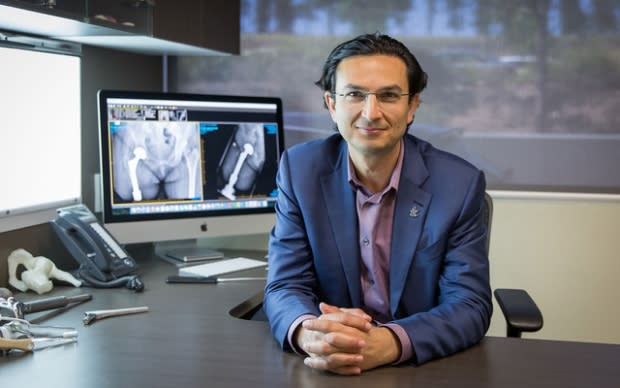Surgeon transforms amputees' mobility by melding bone and metal
When Munjed Al Muderis was 12 years old, he watched The Terminator. That cinematic, science-fiction tale of a futuristic cyborg would ultimately transform his life, inspiring him to pursue a career in orthopedic medicine.
Today, the Iraqi-born surgeon has devoted much of his life to restoring mobility to amputees through a novel surgical procedure known as osseointegration.
"It is an extremely life-changing procedure that transforms amputees' lives," said Al Muderis, speaking from his clinic in Sydney, Australia.
An osseointegration surgery involves inserting a titanium rod-shaped implant into the bone of a patient's amputated limb, with the goal of eventually latching on a state-of-the-art prosthesis. The result is that the new artificial limb stays more firmly in place than a traditional socket-based prosthetic device, allowing for improved mobility and comfort.
Al Muderis, 47, is considered one of the leaders in this cutting-edge field.
He didn't invent the surgical procedure; it was pioneered by a Swedish doctor in the 1990s. Instead, Al Muderis refers to himself as the "Henry Ford" of osseointegration.
Like the American industrial icon, he has revolutionized the technique, opening it up to a wider population of amputees.
Al Muderis redesigned the implant to make it more stable for an amputee's mobility, and to make the surface more porous to allow speedier fusion between the implant and the bone.
Ordered to cut off the ears of deserters
Al Muderis was born in Iraq to an affluent family, and grew up under the regime of Saddam Hussein. He went on to study medicine at the University of Baghdad and by 1999 was a junior medical officer at the city's Saddam Hussein Medical Centre.
Then, during a seemingly mundane day at the hospital, he and his colleagues were confronted by three busloads of army deserters escorted by the Republican Guard, Hussein's elite troops.
"I was going to work, minding my own business — and then all of sudden, everything changed," he said, recalling that pivotal day.

Al Muderis and his fellow doctors were told to stop what they were doing. They were ordered to cut off the deserters' earlobes. When the head of the department refused, citing the Hippocratic Oath, he was killed.
"They took him outside to the car park and put a bullet in his head, then turned to the rest of us and ordered us to continue with the orders," Al Muderis said.
The young surgeon had a choice to make: Obey the command and live with the guilt for the rest of his life, or refuse and end up with a bullet in his head.
He instead chose to escape, sneaking away to hide in the women's washroom for several hours before he felt it was safe to leave the hospital.
Horrific journey to Australia
Knowing he'd be labelled a traitor, what followed was a "horrific journey" out of Iraq, Al Muderis said.
His family smuggled him out of the country and into Jordan. With thousands of dollars taped to his stomach, he flew to Malaysia and onto Indonesia. For the last leg of his voyage, he paid a smuggler $2,000 for a spot on a leaky, unseaworthy boat — loaded with 165 others — bound for Australia.
But he made it, eventually landing at a detention centre in Western Australia, where he was held for several months.
It's a period in his life he describes as "dehumanizing."

Al Muderis was granted asylum in 2000, about 10 months after landing in Australia. He quickly turned his attention back to medicine, got his credentials recognized and landed a job after sending out countless resumés.
He was soon accepted to an elite orthopedic surgery training program, and became enthralled by the emerging technique of osseointegration — a realization of the cybernetic limbs he saw as a boy in The Terminator.
In 2010, Al Muderis created the Osseointegration Group of Australia, where amputees come to be fitted with prosthetic devices through osseointegration surgery. A handful of Canadians surgeons have since travelled to the medical centre for training.
But the surgeon also has lofty ambitions to have the technology available to amputees in developing countries, who can't afford the procedure. He also runs pilot programs in countries like Cambodia, Lebanon and Iraq, where he both performs the surgery and trains local surgeons on the technology.
Today, Al Muderis returns regularly to Iraq, the country he fled so many years ago, to perform surgery on amputees there. Some of them are military patients, he says, former soldiers who lost limbs in the fight against the extremist group ISIS.
"Sadly, the majority of these patients have lost their limbs as a result of explosions and war-related injuries," he said.
And throughout it all, Al Muderis said he's remained committed to restoring mobility to amputees.
"A childhood dream became a reality," he said. "This is my life project."


